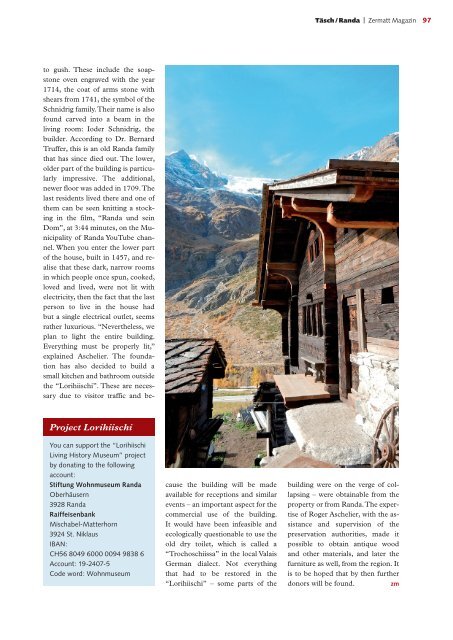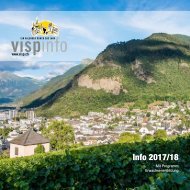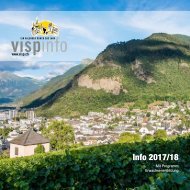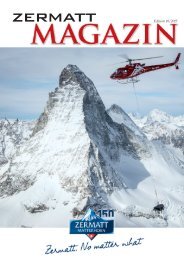Zermatt Magazin 2016
Zermatt Magazin 2015
Zermatt Magazin 2015
Erfolgreiche ePaper selbst erstellen
Machen Sie aus Ihren PDF Publikationen ein blätterbares Flipbook mit unserer einzigartigen Google optimierten e-Paper Software.
Täsch / Randa | <strong>Zermatt</strong> <strong>Magazin</strong> 97<br />
Project Lorihiischi<br />
You can support the “Lorihiischi<br />
Living History Museum” project<br />
by donating to the following<br />
account:<br />
Stiftung Wohnmuseum Randa<br />
Oberhäusern<br />
3928 Randa<br />
Raiffeisenbank<br />
Mischabel-Matterhorn<br />
3924 St. Niklaus<br />
IBAN:<br />
CH56 8049 6000 0094 9838 6<br />
Account: 19-2407-5<br />
Code word: Wohnmuseum<br />
to gush. These include the soapstone<br />
oven engraved with the year<br />
1714, the coat of arms stone with<br />
shears from 1741, the symbol of the<br />
Schnidrig family. Their name is also<br />
found carved into a beam in the<br />
living room: Ioder Schnidrig, the<br />
builder. According to Dr. Bernard<br />
Truffer, this is an old Randa family<br />
that has since died out. The lower,<br />
older part of the building is particularly<br />
impressive. The additional,<br />
newer floor was added in 1709. The<br />
last residents lived there and one of<br />
them can be seen knitting a stocking<br />
in the film, “Randa und sein<br />
Dom”, at 3:44 minutes, on the Municipality<br />
of Randa YouTube channel.<br />
When you enter the lower part<br />
of the house, built in 1457, and realise<br />
that these dark, narrow rooms<br />
in which people once spun, cooked,<br />
loved and lived, were not lit with<br />
electricity, then the fact that the last<br />
person to live in the house had<br />
but a single electrical outlet, seems<br />
rather luxurious. “Nevertheless, we<br />
plan to light the entire building.<br />
Everything must be properly lit,”<br />
explained Aschelier. The foundation<br />
has also decided to build a<br />
small kitchen and bathroom outside<br />
the “Lorihiischi”. These are necessary<br />
due to visitor traffic and because<br />
the building will be made<br />
available for receptions and similar<br />
events – an important aspect for the<br />
commercial use of the building.<br />
It would have been infeasible and<br />
ecologically questionable to use the<br />
old dry toilet, which is called a<br />
“Trochoschiissa” in the local Valais<br />
German dialect. Not everything<br />
that had to be restored in the<br />
“Lorihiischi” – some parts of the<br />
building were on the verge of collapsing<br />
– were obtainable from the<br />
property or from Randa. The expertise<br />
of Roger Aschelier, with the assistance<br />
and supervision of the<br />
preservation authorities, made it<br />
possible to obtain antique wood<br />
and other materials, and later the<br />
furniture as well, from the region. It<br />
is to be hoped that by then further<br />
donors will be found.<br />
zm







